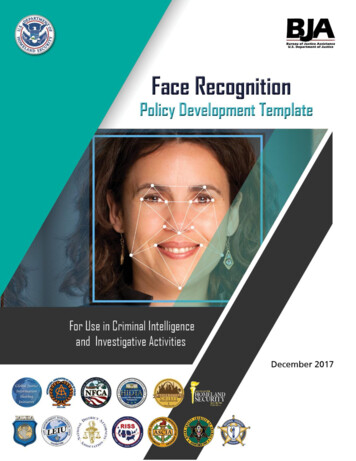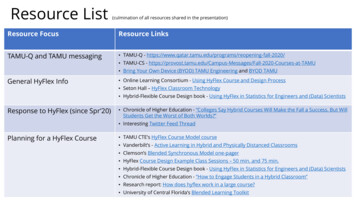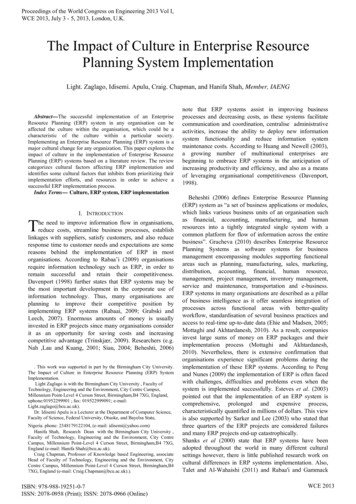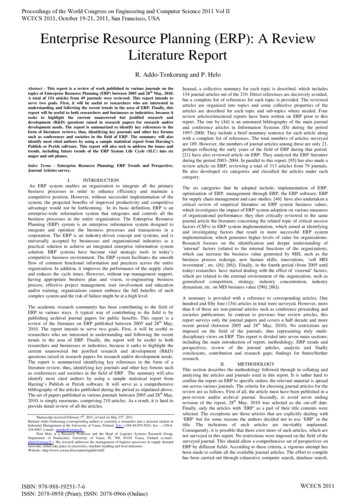
Transcription
Where to Locate This ResourceThis resource is available at www.it.ojp.gov and www.ncirc.gov. To request printed copies, send requests toinformation@ncirc.gov.To Request a Word Version of the TemplateTo request a Word version, send requests to information@ncirc.gov.UpdatesThis resource is considered a living document. Submission of feedback and content suggestions for periodicupdates are encouraged and may be provided by e-mail to information@ncirc.gov.This project was supported by Grant Number 2013-D6-BX-K001 awarded by the Bureau of Justice Assistance,in collaboration with the U.S. Department of Homeland Security. The Bureau of Justice Assistance is acomponent of the Department of Justice’s Office of Justice Programs, which also includes the Bureau of JusticeStatistics, the National Institute of Justice, the Office of Juvenile Justice and Delinquency Prevention, the Officefor Victims of Crime, and the Office of Sex Offender Sentencing, Monitoring, Apprehending, Registering, andTracking. Points of view or opinions in this document are those of the author and do not necessarily representthe official position or policies of the U.S. Department of Justice or the U.S. Department of Homeland Security.
Face Recognition Policy Template forState, Local, and Tribal CriminalIntelligence and Investigative Activities
(This Page Intentionally Left Blank)
Table of ContentsI.Introduction.1Face Recognition Overview .31. How Do Face Recognition Systems Work? .32. Are Face Recognition Results Considered an Identification? .43. Is Face Recognition Information Considered Criminal Intelligence? .4How to Use This Resource .41. Program Versus System .52. What Entities Should Use the Policy Template? .53. Transparency and Referencing Other Policies .64. Mobile Face Recognition Use.65. Face Recognition Analysis on Live Video .76. Template Modifications—Customizing Your Policy .7Resource List .71. Face Recognition and Biometric-Related Resources.72. Policy Development Templates .93. Privacy Regulations and Authorities . 104. Additional Privacy and Security-Related Resources . 10Acknowledgements . 11II. Face Recognition Policy Development Template for State, Local, and Tribal Criminal Intelligenceand Investigative Activities . 13Purpose Statement . 13Policy Applicability and Legal Compliance . 15Face Recognition Policy Template for State, Local, and Tribal Criminal Intelligence and Investigative Activitiesi
Governance and Oversight . 16Definitions . 18Acquiring and Receiving Face Recognition Information . 18Use of Face Recognition Information . 20Sharing and Disseminating Face Recognition Information . 24Data Quality Assurance . 25Disclosure Requests. 26Redress. 26J.1Complaints . 26J.2Requests for Corrections . 27J.3Appeals . 27Security and Maintenance . 27Information Retention and Purging . 31Accountability and Enforcement . 33M.1 Transparency . 33M.2 Accountability . 34M.3 Enforcement . 35Training. 35Appendix A—Glossary of Terms and Definitions . 39Appendix B—Fair Information Practice Principles (FIPPs) . 49Appendix C—Listing of Federal Laws . 53Appendix D—Sample Face Recognition Policy. 59Face Recognition Policy Template for State, Local, and Tribal Criminal Intelligence and Investigative Activitiesii
I. IntroductionFace recognition technology can be a valuable investigativetool to detect and prevent criminal activity; reduce animminent threat to health or safety; protect the public; helpidentify persons unable to identify themselves, or deceasedpersons; and improve security and officer safety. TheNational Center for Missing and Exploited Children(NCMEC), for example, is using face recognition software tosearch the internet for these children.In the past,determining someone’s identity was a manual drawn-outprocess of viewing mug shot images. The use of facerecognition software is helping to streamline this process byreturning investigative results quicker. The purpose of facerecognition technology is not a new one, it’s simply enablinglaw enforcement entities to complete an existing processmore efficiently.However, law enforcement’s use of face recognition tools in investigative and criminal intelligence activities hasbeen the subject of much scrutiny regarding concerns about the accuracy of the technology, use at FirstAmendment-protected events, and assertions that face recognition systems are being used without appropriatesafeguards, such as law, policy, training, and audits. Since images of individual persons are the source of facerecognition information, there are higher expectations for the protection of privacy, civil rights, and civil liberties(P/CRCL). Currently, there is no uniform set of rules in the United States governing the gathering, collection,use, sharing, and dissemination of information available through face recognition tools. The potential for misuseof face recognition information may expose agencies participating in such systems to civil liability and negativepublic perceptions. The lack of rules and protocols also raises concerns that law enforcement agencies will useface recognition systems to systematically, and without human intervention, identify members of the public andmonitor individuals’ actions and movements. Strong control and oversight of face recognition use are criticalconsiderations in policy development and program implementation. Such efforts not only enhance missioneffectiveness but also safeguard P/CRCL of individuals.This policy development template was developed by state, local, and federal law enforcement, privacy, andcriminal justice partners to provide law enforcement, fusion centers, and other public safety agencies with aframework for developing face recognition policies that comply with applicable laws, reduce privacy risks,implement minimum required training for authorized users and examiners, and establish entity accountabilityand oversight. In addition, this template includes policy provisions on collection, access, use, dissemination,data quality, security, redress, retention and purging, and accountability and enforcement, with an overall focuson ensuring the integration of P/CRCL protections in face recognition processes. Established Fair InformationFace Recognition Policy Template for State, Local, and Tribal Criminal Intelligence and Investigative Activities1
Practice Principles form the core of the privacy framework for this template (see Appendix B). Note: The term“entity” is used throughout this resource to refer to the policy-authoring organization.1When an entity determines to develop and implement a face recognition policy, it is important to note that craftingsuch a policy is not a one-time project; it is just one stage in an ongoing entity privacy program cycle:2Stage 1. Educate and raise awareness on the importance ofhaving P/CRCL protections.Stage 2. Assess entity P/CRCL risks by evaluating the processthrough which the entity collects, receives, accesses,uses, disseminates, retains, and purges face recognitioninformation.Stage 3. Develop a face recognition policy to articulate thelegal framework and policy position on how the entityhandles face recognition.Stage 4. Perform a policy evaluation and engage with communitystakeholders, prior to publishing, to determine whetherthe policy adequately addresses current standards,P/CRCL protections, and the law.Stage 5. Implement and train personnel and authorized users onthe established rules and procedures.Stage 6. Perform an annual policy review and make appropriatechanges in response to implementation experience,guidance from oversight or advisory bodies, applicablelaws, technology, and public expectations.Stage 7. Audit the processes described in the face recognition policy.The implementation of proven policies and practices can mitigate the risk of negative impacts while improvingmission effectiveness. As face recognition use expands, it is necessary for law enforcement, fusion centers, andother public safety agencies to ensure that comprehensive policies are developed, adopted, and implementedin order to guide the entity and its personnel in the day-to-day access and use of face recognition technology.Policies that are developed in a transparent manner and which are properly enforced foster trust—not only withinand between justice partners but also by the public. This process helps ensure that justice entities are servingas responsible stewards of face recognition information and operating with respect for individual P/CRCL andthe law.BIOMETRICS POLICIESThis template was developed to address the use of face recognition technology by state, local, tribal, andterritorial (SLTT) law enforcement and public safety entities and fusion centers through the development ofP/CRCL policies. It was not, however, designed to cover all possible biometric modalities, such asfingerprints, palm prints, DNA, familial DNA searching, iris recognition, retina scan, voiceprint, etc. Specificand comprehensive policies are recommended that will appropriately address the use of each biometrictechnology, unique capture methods, complex processes and procedures, and P/CRCL protections.The term “entity” is used throughout this resource to identify the policy-authoring organization and differentiate it fromexternal or participating agencies. Refer to the terms “agency,” “entity,” and “participating agency” in Appendix A—Glossary of Terms and Definitions for more information.2 Global Justice Information Sharing Initiative Privacy Resources, Bureau of Justice Assistance, Office of Justice Program,U.S. Department of Justice, https://it.ojp.gov/privacy.Face Recognition Policy Template for State, Local, and Tribal Criminal Intelligence and Investigative Activities21
Face Recognition OverviewConsidering the potential benefits topublic safety that face recognitiontechnology can offer, it is important thatlaw enforcement and public safetyagencies establish the appropriateframework for ensuring that thetechnology will be used in a responsiblemanner that does not violate P/CRCL.Use of face recognition technology isoften misunderstood. It is not beingused as an all-knowing big brother thatkeeps track of an individual’s weekly—or daily—trips to a business. Moreaccurately, it is a lead generator for law enforcement to investigate criminal activity, akin to a more reliableeye witness. Moreover, facial recognition is not a machine-dominated technology. Generally, entities use—and it is a good practice to do so—a two-part machine-human process—facial recognition, which is softwarebased, and facial comparison, which is human based.31. How Do Face Recognition Systems Work?During enrollment, an image (e.g., a photograph,a digital capture, or a video still) of a face of theknown individual (such as a mug shot) issubmitted to the face recognition system. Whileeach system’s techniques may vary, in general,the distinctive characteristics of each face, suchas the distance between the eyes, the width ofthe nose, and the depth of the eye sockets, aremeasured. These characteristics are known as“nodal points.” Nodal points are extracted fromthe face image and are transformed through theuse of algorithms into a unique file called a“biometric template.”4 A biometric template is areduced set of data that, in face recognitionsystems, represents the unique features of theenrolled person’s face.AlgorithmsAlgorithmsare mathematical equations—calculations, data processing, or automatedreasoning—that are widely used throughoutinformation technology and are the biggest factorsin face recognition accuracy. Since thedevelopment of, and improvements in, algorithmperformance are ongoing and ever evolving,they are not discussed in depth within thisresource. However, policy provisions on dataquality are provided in section H. Data Quality inthe P/CRCL template contained in Chapter II.Entities are strongly encouraged to consideralgorithm performance prior to purchasing a facerecognition system.Biometric templates are then stored in aRefer to the National Institute of Standardsrepository for future comparison with probeand Technology’s (NIST’s) Face Recognitionimages of unknown persons, such as imagesVendor Tests (FRVT), which provide independentgathered during a criminal investigation. Duringgovernment evaluations of commercially availablea face recognition search, the system comparesand prototype face recognition technologies,the biometric template created from a nknown) image with all of the face templatesrecognition-vendor-test-frvt.(of known persons) stored in the repository. Thesystem then provides a list of the most likely candidate photographs (sometimes referred to as a“gallery”5). At this point in the process, the face recognition system has not made a formal identification.Ibid.The term “template,” in this usage (e.g., biometric template), is not to be confused with the term used in the title of thisdocument, which means a template, or guide, for developing a face recognition policy. To avoid confusion, the termbiometric template is not used in the rest of this document but is used here for informational purposes only.5 The term “gallery” is sometimes used by entities when referring to the resulting candidate list. For the purposes of thisdocument, the phrase “list of most likely candidates” will be used.Face Recognition Policy Template for State, Local, and Tribal Criminal Intelligence and Investigative Activities334
After the list is generated, trained human examiners follow-up on the list of most likely candidates byperforming analysis to compare the probe photograph with the candidate photographs.While face recognition is an automated computer evaluation of similarities between face images, facecomparison is a manual examination of the differences and similarities between two face images or alive subject and a face image (one-to-one) for the purpose of determining whether they represent thesame or different persons. The process is used in concert with standard investigative techniques.2. Are Face Recognition Results Considered an Identification?Face recognition search results are not considered positive identification and do not establish probablecause, without further investigation; rather, they are advisory in nature as an investigative lead only. Anypossible connection or involvement of an individual to a criminal investigation must be determinedthrough further analysis and investigation.3. Is Face Recognition Information Considered Criminal Intelligence?The policy template in Chapter II was developed to articulateentity policies and P/CRCL protections for the collection, receipt,access, use, dissemination, retention, and purging of facerecognition information that is not yet part of a criminalintelligence or investigative file. If, after completing the analyticprocess, face recognition information is downloaded into acriminal intelligence or investigative file, the information is thenconsidered criminal intelligence or investigative information andthe laws, regulations, and policies applicable to that type ofinformation govern its use.6Law enforcement, fusion centers, criminal intelligence units, and other public safety entities utilizedifferent types of information, such as criminal history, suspicious activity reports (SARs), and criminalintelligence as part of their criminal intelligence or investigative activities. Each type is governed by laws,regulations, and policies to authorize and ensure appropriate collection, receipt, access, use,dissemination, retention, and purging. Face recognition information—probe photographs, imagerepositories, l
used as an all-knowing big brother that keeps track of an individual’s weekly— or daily—trips to a business. More accurately, it is a lead generator for law enforcement to investigate criminal activity, akin to a more reliable eye witness. Moreover, facial recognition is not a machine-dominated technology. Generally, entities use—











